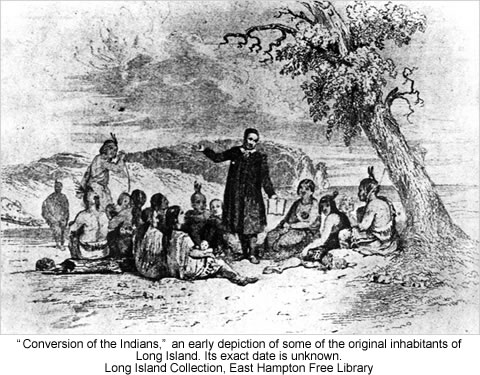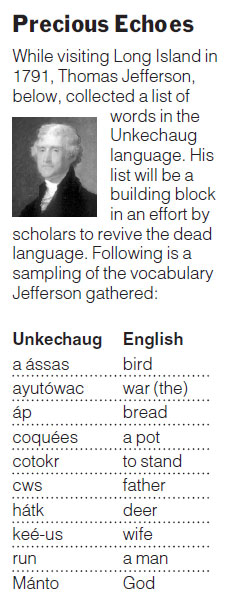 |
Canku Ota
|
 |
|
(Many Paths)
|
||
|
An Online Newsletter
Celebrating Native America
|
||
|
May 1, 2010 - Volume
8 Number 5
|
||
|
|
||
|
Indian Tribes Go
In Search Of Their Lost Languages
|
||
|
by Patricia Cohen -
The New York Times
|
||
| As
far as the records show, no one has spoken Shinnecock or Unkechaug,
languages of Long Island's Indian tribes, for nearly 200 years. Now
Stony Brook University and two of the Indian nations are initiating
a joint project to revive these extinct tongues, using old documents
like a vocabulary list that Thomas Jefferson wrote during a visit
in 1791.
The goal is language resuscitation and enlisting tribal members from this generation and the next to speak them, said representatives from the tribes and Stony Brook's Southampton campus.
"When our children study their own language and culture, they perform better academically," he said. "They have a core foundation to rely on." The Long Island effort is part of a wave of language reclamation projects undertaken by American Indians in recent years. For many tribes language is a cultural glue that holds a community together, linking generations and preserving a heritage and values. Bruce Cole, the former chairman of the National Endowment for the Humanities, which sponsors language preservation programs, has called language "the DNA of a culture." The odds against success can be overwhelming, given the relatively small number of potential speakers and the difficulty in persuading a new generation to participate. There has been progress, though, said Leanne Hinton, professor emerita at the University of California, Berkeley, who created the Breath of Life program in California in 1992 to revive dormant languages in the state. Representatives from at least 25 languages with no native speakers have participated in the group's workshops so far, she said. Last month Ms. Hinton and a colleague at Yale received a federal grant to create a similar program based in Washington, D.C. Of the more than 300 indigenous languages spoken in the United States, only 175 remain, according to the Indigenous Language Institute. This nonprofit group estimates that without restoration efforts, no more than 20 will still be spoken in 2050.
Farther east is Stephanie Fielding, a member of the Connecticut Mohegans and an adviser on the Stony Brook project. She has devoted her life to bringing her tribe's language back to life and is compiling a dictionary and grammar book. In her eyes language provides a mental telescope into the world of her ancestors. She notes, for example, that in an English conversation, a statement is typically built with the first person — "I" — coming first. In the same statement in Mohegan, however, "you" always comes first, even when the speaker is the subject. "This suggests a more communally minded culture," she said. Now in her 60s, Ms. Fielding knows firsthand just how tough it is to sustain a language effort over time, however. She said she was still not fluent. "In order for a language to survive and resurrect," she said, "it needs people talking it, and for people to talk it, there has to be a society that works on it." Chief Wallace of the Unkechaug in Long Island already has a willing student from a younger generation. Howard Treadwell, 24, graduated from Stony Brook in 2009 with a linguistics degree. He will participate in the Long Island effort while doing graduate work at the University of Arizona, where there is a specialized program researching American Indian languages. Mr. Treadwell is one of 400 registered members of the tribe, which maintains a 52-acre reservation in Mastic, on the South Shore. The Shinnecocks have about 1,300 enrolled members and have a reservation adjacent to Southampton.
For the American Indians on Long Island the task is particularly difficult because there are few records. But Shinnecock and Unkechaug are part of a family of eastern Algonquian languages. Some have both dictionaries and native speakers, Mr. Hoberman said, which the team can mine for missing words and phrases, and for grammatical structure. The reclamation is a two-step process, the professor explained. "First we have to figure out what the language looked like," using remembered prayers, greetings, sayings and word lists, like the one Jefferson created, he said. "Then we'll look at languages that are much better documented, look at short word lists to see what the differences are and see what the equivalencies are, and we'll use that to reconstruct what the Long Island languages probably were like." The Massachusett language, for example, is well documented with dictionaries and Bible translations. Jefferson's Unkechaug word list was collected on June 13, 1791, when he visited Brookhaven, Long Island, with James Madison, later his successor in the White House. He wrote that even then, only three old women remained who could still speak the language fluently. Chief Wallace said he had many more records, including religious documents, deeds and legal transactions, and possibly a tape of some tribal members speaking in the 1940s. "When we have an idea of what the language should sound like, the vocabulary and the structure, we'll then introduce it to people in the community," Mr. Hoberman said. While it may seem impossible to recreate the sound of a lost tongue, Mr. Hoberman said the process was not all that mysterious because the dictionaries were transliterated into English. "Would someone from 200 years ago think we had a funny accent?" Mr. Hoberman asked. "Yes. Would they understand it? I hope so." |
|
|
||
|
|
||
| Canku Ota is a free Newsletter celebrating Native America, its traditions and accomplishments . We do not provide subscriber or visitor names to anyone. Some articles presented in Canku Ota may contain copyright material. We have received appropriate permissions for republishing any articles. Material appearing here is distributed without profit or monetary gain to those who have expressed an interest. This is in accordance with Title 17 U.S.C. Section 107. | ||
|
Canku Ota is a copyright ©
2000, 2001, 2002, 2003, 2004, 2005, 2006, 2007, 2008, 2009, 2010
of Vicki Barry and Paul Barry.
|
||
 |
 |
|
|
The "Canku
Ota - A Newsletter Celebrating Native America" web site and
its design is the
|
||
|
Copyright ©
1999, 2000, 2001, 2002, 2003, 2004, 2005,
2006, 2007, 2008, 2009, 2010
of Paul C. Barry.
|
||
|
All Rights Reserved.
|
||
 Chief
Harry Wallace, the elected leader of the Unkechaug Nation, said
that for tribal members, knowing the language is an integral part
of understanding their own culture, past and present.
Chief
Harry Wallace, the elected leader of the Unkechaug Nation, said
that for tribal members, knowing the language is an integral part
of understanding their own culture, past and present.  Some
reclamation efforts have shown success. Daryl Baldwin started working
to revive the dormant language of the Miami Nation in the Midwest
(part of the Algonquian language family), and taught his own children
to speak it fluently. He now directs the Myaamia Project at Miami
University in Ohio, a joint effort between academics and the Miami
tribe.
Some
reclamation efforts have shown success. Daryl Baldwin started working
to revive the dormant language of the Miami Nation in the Midwest
(part of the Algonquian language family), and taught his own children
to speak it fluently. He now directs the Myaamia Project at Miami
University in Ohio, a joint effort between academics and the Miami
tribe.  Robert
D. Hoberman, the chairman of the linguistics department at Stony
Book, is overseeing the academic side of the project. He is an expert
in the creation of modern Hebrew, the great success story of language
revival. Essentially unspoken for 2,000 years, Hebrew survived only
in religious uses until early Zionists tried to update it —
an undertaking adopted on a grand scale when the State of Israel
was established.
Robert
D. Hoberman, the chairman of the linguistics department at Stony
Book, is overseeing the academic side of the project. He is an expert
in the creation of modern Hebrew, the great success story of language
revival. Essentially unspoken for 2,000 years, Hebrew survived only
in religious uses until early Zionists tried to update it —
an undertaking adopted on a grand scale when the State of Israel
was established.